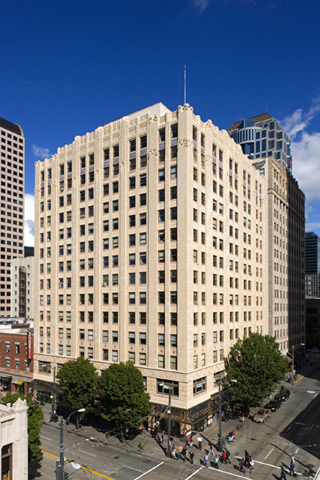
Surveys
DJC.COM
July 30, 2009
For a greener future, look to the past
Weber Thompson

Westcott
|

Keating
|
Economic forces, energy costs and environmental issues are converging to give building owners unprecedented opportunities to deliver bottom-line results and improve asset value. Until the economy recovers, few new buildings will be built and the primary focus for the next several years will be on renovating, remodeling and repositioning existing buildings.
In today’s market, those who own existing buildings are watching vacancy rates trend upwards, along with maintenance and operations costs, while lease rates are in decline. Unstable energy costs paired with inefficiencies in existing buildings, such as single-pane windows and aging mechanical systems, are further burdening the bottom line for building owners.
New city, state and national energy policies will place additional pressure on building owners.
While new, sustainable buildings get the lion’s share of attention in the press, it is existing buildings that have the greatest potential to contribute to our country’s energy conservation goals. In our own state, SB 5854 — which primarily seeks to reduce climate pollution in the built environment — was signed by Gov. Chris Gregoire on May 8 and became effective on July 26. This bill aligns future Washington state energy codes towards the goal of net-zero buildings by 2031.
In addition, and more immediately applicable, SB 5854 requires all new and existing non-residential buildings to disclose their EPA Energy Star rating (similar to a car’s MPG) to prospective lessees or buyers starting in 2011. It is likely that the result of a low Energy Star rating will translate directly to lower building values and/or lower lease rates.

Photo courtesy of William Wright Photography A retrofit to the Vance Building in 2007 resulted in a 73 percent drop in energy needed for heating. |
In addition, the Conference of Mayors led by Seattle Mayor Greg Nickels committed to meet and exceed the targets defined in the Kyoto Protocol. The effort required to meet the protocol will require every new building to be built to a net zero standard — no external energy use and no carbon footprint — and 75 percent of the existing buildings will need to be upgraded to be 40 percent more efficient than current building performance.
While daunting in scale, meeting the targets reflects significant opportunities as recognized by Portland’s sustainability leading development company, Gerding Edlin Development.
Dennis Wilde of GED says, “The next major market will be retrofitting our existing buildings. The existing building stock is terribly inefficient and poses an enormous opportunity for greening our future.”
Not only is this an opportunity to green our future, but it is also a clear opportunity for today’s building owners to add value to their portfolios.
Two major programs are in place to gauge the performance of existing buildings, and in turn, enable owners to plan a strategy to make their buildings more efficient from an operations and maintenance standpoint. The EPA’s Energy Star program is the nationally recognized energy rating program that evaluates a building’s energy performance. A more comprehensive program is the U.S. Green Building Council’s Leadership in Energy and Environmental Design program.
Specifically, LEED for Existing Buildings, Operations and Maintenance is most appropriate when discussing existing building retrofits. It emphasizes both reduction of water and energy use and operations and maintenance. LEED EBOM is purposefully flexible and user-friendly to maximize use and effectiveness.
A March 2008 CoStar Group study found that LEED and Energy Star buildings outperform their peers. The study confirmed that LEED buildings command rent premiums of $11.33 per square foot over non-LEED buildings and have a 4.1 percent higher occupancy rate. The study also found that rental rates in Energy Star buildings generate a $2.40 per square foot premium over comparable non-Energy Star buildings.
To help offset the cost of retrofitting, and to avoid having to buy new sources of energy and water, local utility companies Seattle City Light and Puget Sound Energy have extensive rebate and incentive programs tailored to the specific needs of any project.
The return on investment varies significantly, depending on the scope and complexity of the retrofit or remodel. Here are a few local examples:
• The 3200 Federal Way Building renovation achieved a 6-point increase in its Energy Star rating with a return on investment of 37 percent in 16 months.
• The Wells Fargo Center central plant and automation retrofit received $171,000 in energy savings from April to November last year.
• Seattle’s Pier 66 retrofit reduced its annual electrical usage by more than 50 percent and steam use by 40 percent.
• The Vance Building in downtown Seattle was retrofitted in 2007 to achieve an Energy Star rating of 97 and a 73 percent drop in its energy use for heating. This resulted in 50 percent increases in asset value and lease rates.
The time to act is now. An early 20th century French marshal named Hubert Lyautey said to his gardener, “Could you plant a tree?” The gardener responded, “It’s going to take 50 years before you see anything out of that tree.” The marshal then said, “It’s going to take 50 years, really? Then plant it this morning.”
Jim Westcott, AIA, LEED AP, is Weber Thompson’s principal in charge of commercial projects. Amanda Keating, AIA, LEED AP, is an associate at Weber Thompson who leads the firm’s Green Resources Group.
Other Stories:
- How people influence long-term sustainable success
- Going green with government tax incentives
- Puget Sound’s invisible enemy: polluted stormwater
- Are you sure you’re ready to go green?
- Is vapor intrusion the next regulatory juggernaut?
- Fish find refuge on the lower Puyallup River
- Improving water quality in Holmes Harbor
- A watershed approach to mitigation and restoration
- Why buildings can never be regenerative
Copyright ©2009 Seattle Daily Journal and DJC.COM.
Comments? Questions? Contact us.